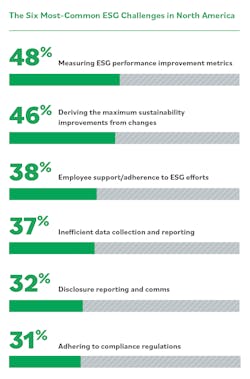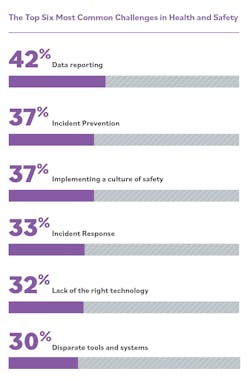Increasingly, corporate leaders are taking note of the relationship between environment, health and safety (EHS) and environmental, social and governance (ESG). EHS and ESG are moving from critical to strategic priorities for every organization, not only for regulatory compliance and worker safety, but also as part of the bigger business picture.
The vast majority (86%) of the 450 EHS professionals recently surveyed by Intelex as part of the research report “Big Ambitions. Complex Data. Limited Visibility” admitted that their organizations must improve health and safety performance, or they risk losing skilled workers to companies that have a better health and safety culture. Some 82% believe that if their organization does not improve its ESG performance, it will negatively impact brand and reputation in the market.
Not surprisingly, EHS and ESG professionals say that gathering and reporting data is their organizations’ most likely health and safety-related challenge, followed by implementing a culture of safety and incident prevention. Nearly all (97%) of those surveyed reported data- and compliance-related challenges when it comes to ESG, including measuring performance improvement metrics and ROI; insufficient data collection, calculation and reporting; and regulatory compliance (see Figures 1 and 2).
Changing Work and Changing Focus
Research published in 2022 by the National Safety Council (NSC) suggests that while EHS is increasingly being asked to engage in ESG initiatives, it is not yet fully entrenched in ESG strategy development. During a recent webinar, John Dony, vice president of workplace strategy for the NSC, shared that 85% of 750 EHS and ESG professionals the council surveyed said EHS has some level of involvement in the execution of ESG strategies.
But the NSC research also reveals only about a quarter of those respondents believe EHS is a key partner and stakeholder in ESG. More often, EHS has a much narrower ESG focus, particularly around execution of employee safety and health, plus in areas that include the social pillar of ESG and human capital.
Three-quarters of those surveyed by the NSC say they currently include safety and health metrics in their ESG metrics, but Dony says these are commonly tracked lagging metrics, such as total recordable incident rates and lost-time incidents. He describes these metrics as low-hanging fruit and not good representations of actual safety capacity or performance.
“If the goal is to understand actual safety ability, capacity and presence of defenses, then we should probably be looking at different metrics,” he says. “We know that there are better ways to visualize and understand.”
Scott Gaddis, vice president and global practice leader for health and safety at Intelex Technologies, says EHS professionals will play an increasingly important role in ESG’s future. Gaddis believes ESG will become a public report card, used to compare companies and competitors against each other. EHS data will be used by investors to evaluate the ESG performance of companies, he says. That means EHS professionals will take on increasing responsibility for ESG and business success.
“For the EHS professional, EHS and ESG inevitably will cross paths,” Gaddis says. “While ESG serves as a framework for investors and others interested in evaluating a company, EHS is a bit different as it is a business function residing inside of an organization to maintain compliance and eliminate or mitigate loss potential. With that said, it’s not a hard stretch to understand that EHS is heavily embedded within the ESG reporting system, especially in the environment and social pillars.”
For the environment pillar, both the EHS and ESG functions seek to control impacts on the environment, energy, people and the public in the communities where work occurs. Gaddis says they find occupational health and safety metrics landing in ESG reporting under the social pillar but managed as an output from programs directed by internal EHS teams. Employee injury and illness, product safety, community protections and labor are but a few possible data collection points for the EHS professional to consider programming to better controls, according to Gaddis.
“We’re not going to wiggle away from this,” Gaddis says. “We’re part of that social pillar within ESG, so we’ve got a lot of work there to do.” In addition to providing data for ESG reporting, Gaddis says EHS professionals need to continue positioning themselves as ESG leaders within their organizations.
“It’s evident that the role of an EHS professional will change to include some ESG responsibilities. However, it’s also important to understand that it’s bigger than EHS, meaning that ESG will need to pull data, intelligence and resources from across an entire organization, including HR, operations, maintenance, training development, supply chain and other functional support organizations,” he adds.
The Difficulty of Data
The fact that both EHS and ESG are data-intensive is perceived as both an opportunity and a challenge, which explains why data collection makes it to the top of the list of challenges for both EHS and ESG professionals. While there is a rich supply of data to work with, such huge amounts of data can be difficult to manage, even for sophisticated organizations. This is particularly true if those organizations utilize multiple technologies, have siloed information or do not provide their teams with access to the same applications or software.
The ability to collect data and be assured it is of high quality are essential to the success of both EHS and ESG reporting and compliance success. Traditional and ad hoc ways of collecting ESG and EHS data are not enough, says Virginia Hoekenga, deputy director for the National Association for Environmental Managers (NAEM). Hoekenga believes companies must move from spreadsheets and paper approaches to systemic and holistic management of ESG and EHS using information technology and digital systems.
The EHS and ESG professionals surveyed for the Intelex report say they are challenged in their efforts to gather EHS and ESG data and admit that poor data quality hinders their ability to improve EHS and ESG performance. In fact, only four in 10 respondents say they are confident in the accuracy of their ESG data.
Hoekenga believes a big part of that problem may be a lack of specifically designed technologies and applications for ESG data monitoring, management and reporting. “We’ve got to arrive at a place where companies have data management,” she says. “Organizations need to track and have a multidimensional view of [ESG] performance. We still see a lot of data silos that slow down that ability to get a multidimensional view. A big push in our conversation about maturing ESG management is having the ability to analyze and compare data from different systems… and providing better systems integration, such as with enterprise management and human resources.”
Pulling it all Together
Health and safety professionals increasingly are using technology to meet their core objectives. At the same time, they’re battling to make disparate systems work seamlessly together. This is making it difficult for them to get a clear picture of what’s really happening across their organizations. It’s also making it more challenging to react to incidents in a timely manner or track and act on near misses.
The picture is similar in ESG. Many businesses are using software and technology to help meet ambitious targets. However, just as many are struggling to link these systems together to provide the information and insight they need to make the progress they and their customers demand.
EHS and ESG professionals can take one of two approaches, says Trevor Bronson, director of portfolio strategy at Intelex, who formerly worked in EHS/sustainability engineering at automaker Tesla and as an EHSS systems analyst for paint company Benjamin Moore & Co. “The first approach is to implement a holistic ESG management tool that can be used to collect, aggregate, organize, report and improve all types of ESG data [regardless of] whether the data is sourced from EHS, from engineering or from the C-suite. The second is to let these departments manage their relationships with broader ESG goals separately but ensure the different tools being used all play nicely together and can efficiently get data where it needs to go.”
The bottom line, Bronson says, is this: ESG data—whether it is generated by EHS practitioners, the engineering department, sustainability professionals or others—is an incredibly broad data set yet increasingly scrutinized. “Information needs to be timely, accurate, cross-departmental and organized.”
Sandy Smith is the director of content and brand for Intelex Technologies and the former content director for EHS Today.
About the Author

Sandy Smith
Sandy Smith is the former content director of EHS Today, and is currently the EHSQ content & community lead at Intelex Technologies Inc. She has written about occupational safety and health and environmental issues since 1990.


